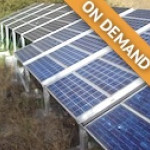10-21-2014 - Introduction to Solar Photovoltaic Webinar - Online, Live
Training Provider: APT Corporate Training Services
Dates: TU Oct 21, WE Oct 22, TH Oct 23, TU Oct 28, WE Oct 29, TH Oct 30 from 12:00pm to 4:00pm ET
Location: Webinar, Live
 No Reviews
No Reviews
We're sorry, but registration for this event has ended
View Upcoming Introduction to Solar Photovoltaic Webinar In Online, Live| TICKET TYPE | PRICE | QUANTITY |
|---|---|---|
|
One Workshop Ticket more info» | $995.00 | Registration Ended |
| Registration Ended | ||
Why Should You Take This Introduction to Solar Photovoltaic Webinar?
This Introduction to Solar Photovoltaic webinar provides a comprehensive understanding of small size solar photovoltaic systems, referred to as residential systems. The basic electrical principles as they apply to photovoltaic systems are reviewed, and the fundamental solar energy concepts explored.
The course explains basic installation methods for both grid-tied and stand-alone photovoltaic systems, and thoroughly describes the components used for their construction. Students will learn how to correctly size each part taking into account load, budget, system geographical location, and National Electric Code requirements. Troubleshooting practices as well as safety rules while working around a residential photovoltaic system are also introduced.
Target Audience: For students who want an in-depth understanding of Solar Photovoltaic systems, who are interested in pursuing job positions in this industry or those considering adding solar power to their homes.
Learning Outcomes:
- Describe the characteristics of small size (residential) solar photovoltaic systems.
- List the components of a photovoltaic system and describe their functions.
- Understand how to design and size a photovoltaic system considering load requirements, budget constraints, and the environmental and construction factors affecting its performance
- Discuss the basic installation methods for different types of small size PV systems
- List and describe safety rules while working on a photovoltaic system as pertains to electrical safety and construction site safety
Benefits of Completing Training:
- Students learn valuable knowledge and skills needed to expand and diversify their career opportunities in the renewable energy industry.
- Students obtain a working knowledge of photovoltaic concepts, how PV systems are sized to meet energy consumption needs and the practices used for installation and maintenance of systems.
Prerequisites: There are no prerequisites for taking this course
Part A - Fundamentals:
Chapter 1 - Introduction to Photovoltaics
This chapter introduces small size photovoltaic systems both connected to the grid (grid-tied) and stand-alone types. Typical examples of PV installations are described as well as the function of the main components.
Chapter 2 - Basic Electrical Principles
Series and parallel electrical circuits are reviewed in this chapter along with the basic electrical laws used to calculate voltage, current and power. The same laws and calculations are applied to solar panels in order to design mixed series-parallel PV arrays and battery banks having the required output values.
Chapter 3 - Solar Energy Fundamentals
This chapter introduces the fundamentals of solar energy to be considered when designing a PV system. The position of the sun in the sky related to earth latitude and time of the day is illustrated and used to determine the PV array orientation and tilt maximizing its efficiency. Techniques used to measure the shading on a PV site all year-round are also illustrated.
Part A Objectives:
Upon completion of Part A of this course, students will be able to:
- Describe the characteristics of a PV system and explain the function of its main components
- Calculate voltage, current, and power for series and parallel circuits and apply the same calculations to series and parallel battery banks and PV arrays of panels
- Explain the fundamentals of solar energy such as irradiance, insolation, peak sun hours, sun position in the sky, and apply these concepts to PV system design
Part B - Advanced Concepts:
Chapter 4 - Site Electrical Design
This chapter explains how to determine the PV array size for a grid-tied system using energy consumption data. It also illustrates how to determine the size of the battery bank for a stand-alone system to zero out the daily average load. How energy audits are used to calculate total load requirements when data is not available is illustrated as well.
Chapter 5 - Photovoltaic Panels and Inverters
In this chapter the characteristics and operation of solar cells, solar panels, and inverters are discussed. I-V curves which summarize the characteristics of solar panels measured under Standard Test Conditions (STC) are illustrated as well as PV panels and inverters specifications. Environmental factors affecting the performance of solar panels are introduced.
Chapter 6 - Battery and Charge Controllers
The characteristics of several types of deep cycle lead-acid batteries and charge controllers used in stand-alone PV system installations are described in this chapter. Constructions and environmental factors affecting batteries performance and life expectancy are illustrated as well.
Chapter 7 - Photovoltaic Systems Wire
The basics of PV system wiring is covered in this chapter with the intent of providing safe and reliable construction practices in accordance with current NEC and building code articles.PV systems wire sizing considering ampacity and grounding NEC® regulations as well as maximum allowed voltage drop is discussed.
Part B Objectives:
Upon completion of Part B of this course, students will be able to:
- Explain the criteria to consider for sizing a grid-tied and a stand-alone photovoltaic system taking into account load requirements and budget
- Describe solar modules and inverters features and specifications under different standard conditions and illustrate panel I-V curves
- Discuss the various types of deep cycle lead-acid batteries and charge controllers used with PV systems and describe their features, applications, and factors that affect their performance
- Determine wire size for a PV system using ampacity and voltage drop limitations and discuss grounding requirements as listed in current NEC® standards
Part C - Installation Procedures:
Chapter 8 – PV Installation, Maintenance, and Troubleshooting
This chapter discusses different types of PV installations both on rooftops and on the ground. Maintenance and troubleshooting procedures taking into account construction and electrical NEC® requirements are listed and described for both grid-tied and stand-alone systems with battery banks.
Chapter 9 - Safety
This chapter illustrates the importance of electrical and construction safety rules when installing and maintaining PV systems. Standard safety rules included in the NEC®, UL, and OSHA publications related to PV systems installations, maintenance, and troubleshooting are introduced.
Part C Objectives:
Upon completion of Part C of this course, students will be able to:
- List and describe installation practices, procedures, and safety considerations for all aspects and elements of a PV system
- Discuss general safety rules while working on a PV system as pertains to electrical safety, construction site safety, and working aloft safety
| COURSE LOGISTICS | |
|---|---|
| Certificates | 1-3 days after course completion |
| Food | Snacks will be provided |
This course is conducted as a live instructor-led webinar. Further details will be provided to you prior to the course.
TU Oct 21, WE Oct 22, TH Oct 23, TU Oct 28, WE Oct 29, TH Oct 30 from 12:00pm to 4:00pm ET

This partner no longer posts classes on Zack Academy. For a complete list of classes, please visit our course catalog.
APT Corporate Training Services was founded in 1993 by CEO Steven W. Blume to offer electric power and telecommunications training. In 2003 Applied Professional Training became a Distance Education and Training Council accredited institution. APT has gained the reputation as being the premier technical training provider for the telecommunications and electric power industries, and recently added renewable energy training to its repertoire. APT not only offers professional certificates and college degrees, but also offers career-oriented courses designed to enhance employee knowledge, skills, and abilities and proctors industry certifications related to both current and emerging technologies.

Questions? 954-400-0595

